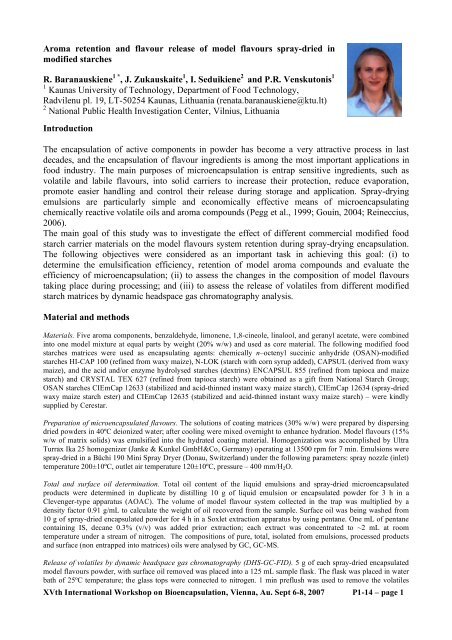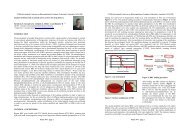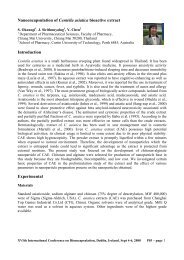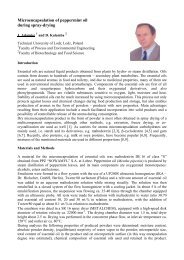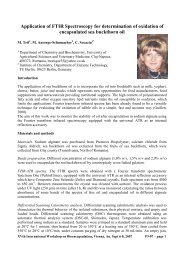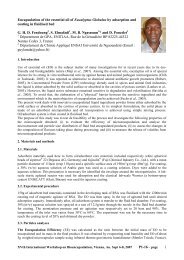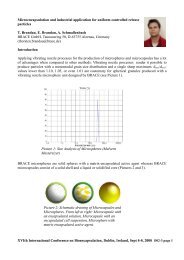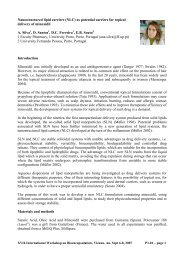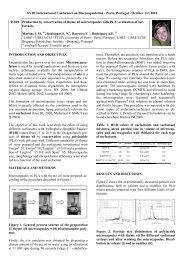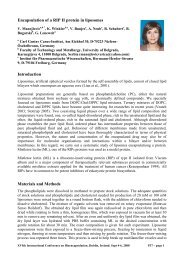Aroma retention and flavour release of model flavours spray-dried in ...
Aroma retention and flavour release of model flavours spray-dried in ...
Aroma retention and flavour release of model flavours spray-dried in ...
You also want an ePaper? Increase the reach of your titles
YUMPU automatically turns print PDFs into web optimized ePapers that Google loves.
<strong>Aroma</strong> <strong>retention</strong> <strong>and</strong> <strong>flavour</strong> <strong>release</strong> <strong>of</strong> <strong>model</strong> <strong>flavour</strong>s <strong>spray</strong>-<strong>dried</strong> <strong>in</strong><br />
modified starches<br />
R. Baranauskiene 1 * , J. Zukauskaite 1 , I. Seduikiene 2 <strong>and</strong> P.R. Venskutonis 1<br />
1 Kaunas University <strong>of</strong> Technology, Department <strong>of</strong> Food Technology,<br />
Radvilenu pl. 19, LT-50254 Kaunas, Lithuania (renata.baranauskiene@ktu.lt)<br />
2 National Public Health Investigation Center, Vilnius, Lithuania<br />
Introduction<br />
The encapsulation <strong>of</strong> active components <strong>in</strong> powder has become a very attractive process <strong>in</strong> last<br />
decades, <strong>and</strong> the encapsulation <strong>of</strong> <strong>flavour</strong> <strong>in</strong>gredients is among the most important applications <strong>in</strong><br />
food <strong>in</strong>dustry. The ma<strong>in</strong> purposes <strong>of</strong> microencapsulation is entrap sensitive <strong>in</strong>gredients, such as<br />
volatile <strong>and</strong> labile <strong>flavour</strong>s, <strong>in</strong>to solid carriers to <strong>in</strong>crease their protection, reduce evaporation,<br />
promote easier h<strong>and</strong>l<strong>in</strong>g <strong>and</strong> control their <strong>release</strong> dur<strong>in</strong>g storage <strong>and</strong> application. Spray-dry<strong>in</strong>g<br />
emulsions are particularly simple <strong>and</strong> economically effective means <strong>of</strong> microencapsulat<strong>in</strong>g<br />
chemically reactive volatile oils <strong>and</strong> aroma compounds (Pegg et al., 1999; Gou<strong>in</strong>, 2004; Re<strong>in</strong>eccius,<br />
2006).<br />
The ma<strong>in</strong> goal <strong>of</strong> this study was to <strong>in</strong>vestigate the effect <strong>of</strong> different commercial modified food<br />
starch carrier materials on the <strong>model</strong> <strong>flavour</strong>s system <strong>retention</strong> dur<strong>in</strong>g <strong>spray</strong>-dry<strong>in</strong>g encapsulation.<br />
The follow<strong>in</strong>g objectives were considered as an important task <strong>in</strong> achiev<strong>in</strong>g this goal: (i) to<br />
determ<strong>in</strong>e the emulsification efficiency, <strong>retention</strong> <strong>of</strong> <strong>model</strong> aroma compounds <strong>and</strong> evaluate the<br />
efficiency <strong>of</strong> microencapsulation; (ii) to assess the changes <strong>in</strong> the composition <strong>of</strong> <strong>model</strong> <strong>flavour</strong>s<br />
tak<strong>in</strong>g place dur<strong>in</strong>g process<strong>in</strong>g; <strong>and</strong> (iii) to assess the <strong>release</strong> <strong>of</strong> volatiles from different modified<br />
starch matrices by dynamic headspace gas chromatography analysis.<br />
Material <strong>and</strong> methods<br />
Materials. Five aroma components, benzaldehyde, limonene, 1,8-c<strong>in</strong>eole, l<strong>in</strong>alool, <strong>and</strong> geranyl acetate, were comb<strong>in</strong>ed<br />
<strong>in</strong>to one <strong>model</strong> mixture at equal parts by weight (20% w/w) <strong>and</strong> used as core material. The follow<strong>in</strong>g modified food<br />
starches matrices were used as encapsulat<strong>in</strong>g agents: chemically n–octenyl succ<strong>in</strong>ic anhydride (OSAN)-modified<br />
starches HI-CAP 100 (ref<strong>in</strong>ed from waxy maize), N-LOK (starch with corn syrup added), CAPSUL (derived from waxy<br />
maize), <strong>and</strong> the acid <strong>and</strong>/or enzyme hydrolysed starches (dextr<strong>in</strong>s) ENCAPSUL 855 (ref<strong>in</strong>ed from tapioca <strong>and</strong> maize<br />
starch) <strong>and</strong> CRYSTAL TEX 627 (ref<strong>in</strong>ed from tapioca starch) were obta<strong>in</strong>ed as a gift from National Starch Group;<br />
OSAN starches CIEmCap 12633 (stabilized <strong>and</strong> acid-th<strong>in</strong>ned <strong>in</strong>stant waxy maize starch), CIEmCap 12634 (<strong>spray</strong>-<strong>dried</strong><br />
waxy maize starch ester) <strong>and</strong> CIEmCap 12635 (stabilized <strong>and</strong> acid-th<strong>in</strong>ned <strong>in</strong>stant waxy maize starch) – were k<strong>in</strong>dly<br />
supplied by Cerestar.<br />
Preparation <strong>of</strong> microencapsulated <strong>flavour</strong>s. The solutions <strong>of</strong> coat<strong>in</strong>g matrices (30% w/w) were prepared by dispers<strong>in</strong>g<br />
<strong>dried</strong> powders <strong>in</strong> 40ºC deionized water; after cool<strong>in</strong>g were mixed overnight to enhance hydration. Model <strong>flavour</strong>s (15%<br />
w/w <strong>of</strong> matrix solids) was emulsified <strong>in</strong>to the hydrated coat<strong>in</strong>g material. Homogenization was accomplished by Ultra<br />
Turrax Ika 25 homogenizer (Janke & Kunkel GmbH&Co, Germany) operat<strong>in</strong>g at 13500 rpm for 7 m<strong>in</strong>. Emulsions were<br />
<strong>spray</strong>-<strong>dried</strong> <strong>in</strong> a Büchi 190 M<strong>in</strong>i Spray Dryer (Donau, Switzerl<strong>and</strong>) under the follow<strong>in</strong>g parameters: <strong>spray</strong> nozzle (<strong>in</strong>let)<br />
temperature 200±10ºC, outlet air temperature 120±10ºC, pressure – 400 mm/H 2 O.<br />
Total <strong>and</strong> surface oil determ<strong>in</strong>ation. Total oil content <strong>of</strong> the liquid emulsions <strong>and</strong> <strong>spray</strong>-<strong>dried</strong> microencapsulated<br />
products were determ<strong>in</strong>ed <strong>in</strong> duplicate by distill<strong>in</strong>g 10 g <strong>of</strong> liquid emulsion or encapsulated powder for 3 h <strong>in</strong> a<br />
Clevenger-type apparatus (AOAC). The volume <strong>of</strong> <strong>model</strong> <strong>flavour</strong> system collected <strong>in</strong> the trap was multiplied by a<br />
density factor 0.91 g/mL to calculate the weight <strong>of</strong> oil recovered from the sample. Surface oil was be<strong>in</strong>g washed from<br />
10 g <strong>of</strong> <strong>spray</strong>-<strong>dried</strong> encapsulated powder for 4 h <strong>in</strong> a Soxlet extraction apparatus by us<strong>in</strong>g pentane. One mL <strong>of</strong> pentane<br />
conta<strong>in</strong><strong>in</strong>g IS, decane 0.3% (v/v) was added prior extraction; each extract was concentrated to ~2 mL at room<br />
temperature under a stream <strong>of</strong> nitrogen. The compositions <strong>of</strong> pure, total, isolated from emulsions, processed products<br />
<strong>and</strong> surface (non entrapped <strong>in</strong>to matrices) oils were analysed by GC, GC-MS.<br />
Release <strong>of</strong> volatiles by dynamic headspace gas chromatography (DHS-GC-FID). 5 g <strong>of</strong> each <strong>spray</strong>-<strong>dried</strong> encapsulated<br />
<strong>model</strong> <strong>flavour</strong>s powder, with surface oil removed was placed <strong>in</strong>to a 125 mL sample flask. The flask was placed <strong>in</strong> water<br />
bath <strong>of</strong> 25ºC temperature; the glass tops were connected to nitrogen. 1 m<strong>in</strong> preflush was used to remove the volatiles<br />
XVth International Workshop on Bioencapsulation, Vienna, Au. Sept 6-8, 2007 P1-14 – page 1
accumulated <strong>in</strong> the gas phase. Then sample was purged with the nitrogen at a flow <strong>of</strong> 400 mL m<strong>in</strong> -1 to recover the<br />
volatiles accumulated <strong>in</strong> the headspace dur<strong>in</strong>g the timed <strong>in</strong>terval. The volatiles trapped on 0.5 g Tenax, TA 35/60 mesh<br />
were desorbed by 15 mL <strong>of</strong> diethyl ether. Tub<strong>in</strong>gs were changed every 10 m<strong>in</strong>. The total purge time was 100 m<strong>in</strong>. After<br />
add<strong>in</strong>g 1 mL IS (decane <strong>in</strong> diethyl ether 0.3 % v/v) to the desorbed volatiles, they were evaporated to a f<strong>in</strong>al volume <strong>of</strong><br />
1 mL under a stream <strong>of</strong> nitrogen <strong>and</strong> analysed by GC <strong>and</strong> GC-MS. Two replicates were carried out for each sample.<br />
GC. Diluted <strong>in</strong> pentane pure <strong>model</strong> <strong>flavour</strong>s, samples <strong>of</strong> reta<strong>in</strong>ed after <strong>spray</strong>-dry<strong>in</strong>g total <strong>and</strong> surface oils (10 µL <strong>in</strong> 1<br />
mL) were analysed on a Fisons 8000 series GC equipped with a flame ionization detector (FID) <strong>and</strong> a DB-5 fused silica<br />
capillary column (polydimethylsiloxane, 5% phenyl, 50 m length, 0.32 mm i.d., 0.25 µm film thickness). The carrier<br />
gas was helium at a l<strong>in</strong>ear flow velocity <strong>of</strong> 43 cm s -1 at 50 ºC; the detector’s temperature was 320 ºC, the oven<br />
temperature was programmed from 50 ºC (2 m<strong>in</strong>) to 280 ºC (10 m<strong>in</strong>) at the ratio <strong>of</strong> 5 ºC m<strong>in</strong> -1 . A split/splitless <strong>in</strong>jector<br />
was used at 260 ºC <strong>in</strong> split mode at a ratio <strong>of</strong> 1:5, the <strong>in</strong>jection volume was 1 µL. The content <strong>of</strong> eluted compounds was<br />
expressed as GC peak area percent; mean values were calculated from quadruplicate <strong>in</strong>jections. The coefficient <strong>of</strong><br />
variation is def<strong>in</strong>ed as the ratio <strong>of</strong> correspond<strong>in</strong>g st<strong>and</strong>ard deviation (%RSD) to the average value from 4 replicate<br />
<strong>in</strong>jections.<br />
The <strong>model</strong> <strong>flavour</strong>s trapped on Tenax tubes <strong>and</strong> then desorbed by thermal desorption device were directed through a<br />
heated transfer l<strong>in</strong>e to <strong>in</strong>jection port <strong>of</strong> a Shimadzu GC-2010 series gas chromatograph equipped with a flame ionization<br />
detector (FID) <strong>and</strong> FS-SE-54-CB-0.5 fused silica capillary column (50 m length, 0.25 mm i.d., 0.5 µm film thiskness).<br />
The carrier gas was nitrogen at a l<strong>in</strong>ear flow velocity <strong>of</strong> 29 cm s -1 at 50ºC; the detectors temperature was 300ºC, the<br />
oven temperature was programmed from 50ºC (2 m<strong>in</strong>) to 230ºC at the ratio <strong>of</strong> 10ºC m<strong>in</strong> -1 . A split/splitless <strong>in</strong>jector was<br />
used at 280ºC <strong>in</strong> split mode at ratio <strong>of</strong> 1:5, the <strong>in</strong>jection volume was 1µL.<br />
GC-MS. GC-MS analyses were performed us<strong>in</strong>g a Perk<strong>in</strong> Elmer Clarus 500 GC coupled to a Perk<strong>in</strong> Elmer Clarus 500<br />
series mass selective detector <strong>in</strong> the electron impact ionization mode at 70eV, the mass range was m/z 29-550. Volatile<br />
compounds were separated us<strong>in</strong>g an Elite – 5 MS capillary column (dimethylpolysiloxane, 5% diphenyl, 30 m length,<br />
0.25 mm i.d., 0.25 µm film thickness). The oven temperature was programmed from 50 ºC (for 2 m<strong>in</strong>) to 280 ºC (hold<br />
10 m<strong>in</strong>) at the ratio <strong>of</strong> 5 ºC m<strong>in</strong> -1 . Carrier gas, helium, adjusted to a l<strong>in</strong>ear velocity <strong>of</strong> 36.2 cm s -1 at 50 ºC. Split mode<br />
was used at ratio <strong>of</strong> 1:20 <strong>and</strong> an <strong>in</strong>jector temperature <strong>of</strong> 250 ºC.<br />
The components were identified by comparison their Kovats <strong>retention</strong> <strong>in</strong>dexes (KI) related to C 5 -C 18 n-alkanes obta<strong>in</strong>ed<br />
on nonpolar column with those provided <strong>in</strong> the literature (Adams, 2001) <strong>and</strong> by comparison <strong>of</strong> their mass spectra with<br />
the data provided by the NIST mass spectral library.<br />
Statistical analysis. Data were statistically h<strong>and</strong>led by one-way analysis <strong>of</strong> variance (ANOVA, vers. 2.2., 1999).<br />
Duncan’s multiple-range test was applied for the calculation <strong>of</strong> the significant differences among the microencapsulated<br />
<strong>in</strong>to different wall materials <strong>model</strong> <strong>flavour</strong> system products, at the probability level P=0.05.<br />
Results <strong>and</strong> discussion<br />
Properties <strong>of</strong> liquid emulsion <strong>and</strong> <strong>spray</strong>-<strong>dried</strong> microencapsulated products. Total oil content <strong>in</strong><br />
liquid homogenized <strong>model</strong> <strong>flavour</strong> system emulsion ranged from 13.46 g 100g -1 for ENCAPSUL<br />
855-emulsified product to 14.73 g 100g -1 for N-LOK, CIEmCap 12634 <strong>and</strong> 12635-emulsified<br />
products (Table 1). Emulsification efficiency <strong>of</strong> <strong>model</strong> <strong>flavour</strong>s <strong>in</strong> the liquid emulsions varied from<br />
89.71% (ENCAPSUL 855) to 98.71% (CIEmCap 12635). There were no statistical differences <strong>in</strong><br />
emulsification efficiency <strong>of</strong> oil <strong>in</strong> liquid emulsions at P=0.05 almost for all modified starches. It<br />
mostly depends to the emulsification properties <strong>of</strong> matrix <strong>and</strong> its tendency to form films at the<br />
<strong>in</strong>terfaces between the emulsion phases; this is <strong>in</strong> agreement that maltodextr<strong>in</strong>s usually lack the<br />
emulsification efficiency (Pegg et al., 1999). The high volatility <strong>and</strong> solubility <strong>of</strong> <strong>flavour</strong>s might<br />
also lead a higher loss <strong>of</strong> <strong>flavour</strong>s dur<strong>in</strong>g <strong>spray</strong>-dry<strong>in</strong>g (Soottitantawat et al., 2003).<br />
The total oil content <strong>of</strong> the <strong>spray</strong>-<strong>dried</strong> <strong>model</strong> <strong>flavour</strong>s products were statistically different at<br />
P=0.05 <strong>and</strong> ranged from 8.85 g 100g -1 (ENCAPSUL 855) to 14.24 g 100g -1 (CAPSUL) (Table 1).<br />
The lowest ability to reta<strong>in</strong> <strong>model</strong> <strong>flavour</strong>s was obta<strong>in</strong>ed for both dextr<strong>in</strong>es matrices <strong>in</strong> our study.<br />
The literature show that maltodextr<strong>in</strong>s do not perform excellent <strong>in</strong> volatiles <strong>retention</strong>. It was<br />
reported that maltodextr<strong>in</strong>s reta<strong>in</strong> aroma compounds well that are water soluble or soluble at their<br />
use level; the poor <strong>retention</strong> <strong>of</strong> <strong>in</strong>soluble aroma compounds by maltodextr<strong>in</strong>s relates to their lack <strong>of</strong><br />
emulsification properties (Re<strong>in</strong>eccius et al., 2003).<br />
The content <strong>of</strong> oil rema<strong>in</strong>ed on the surface <strong>of</strong> the <strong>spray</strong>-<strong>dried</strong> powder is important factor for storage<br />
stability, because surface oil can be easily oxidized <strong>and</strong> form unacceptable <strong>of</strong>f-<strong>flavour</strong> compounds.<br />
XVth International Workshop on Bioencapsulation, Vienna, Au. Sept 6-8, 2007 P1-14 – page 2
The content <strong>of</strong> surface oil on the <strong>spray</strong>-<strong>dried</strong> microencapsulated <strong>model</strong> <strong>flavour</strong>s products powder<br />
particles varied from 0.12 g 100 g -1 for N-LOK to 0.30 g 100 g -1 for ENCAPSUL 855 encapsulated<br />
products. The moisture content <strong>of</strong> <strong>spray</strong>-<strong>dried</strong> microencapsulated <strong>model</strong> <strong>flavour</strong>s products ranged<br />
from 1.20 mL 100 g -1 (CIEmCap 12634) to 3.13 mL 100 g -1 (CAPSUL) (Table 1).<br />
Table 1. Properties <strong>of</strong> liquid emulsion <strong>and</strong> <strong>spray</strong>-<strong>dried</strong> microencapsulated <strong>model</strong> <strong>flavour</strong>s products<br />
HI-CAP<br />
100<br />
N-LOK CAPSUL ENC 855<br />
CR TEX<br />
627<br />
CIEmCa<br />
p 12633<br />
CIEmCa<br />
p 12634<br />
CIEmCa<br />
p 12635<br />
liquid microencapsulated product<br />
total oil content, g 100 g -1 13.86 abc 14.73 cd 14.49 abc 13.46 a 14.17 abc 14.57 abc 14.73 bc 14.81 c<br />
emulsification efficiency, * % 92.38 ab 98.18 cde 96.60 cde 89.74 a 94.49 bc 97.13 cde 98.18 cde 98.71 c<br />
<strong>spray</strong>-<strong>dried</strong> microencapsulated product<br />
total oil content, g 100 g -1 12.88 b 12.40 f 14.24 cd 8.85 a 10.41 e 13.97 cd 12.87 b 13.71 d<br />
surface oil content, g 100 g -1 0.15 bc 0.12 a 0.14 ab 0.30 f 0.19 d 0.14 ab 0.17 cd 0.22 e<br />
encapsulation efficiency, * % 84.84 bc 81.89 b 94.0 e 56.98 a 70.68 f 92.26 cde 84.73 bc 89.91 cde<br />
moisture, mL 100 g -1 1.28 a 2.75 bcd 3.13 d 2.21 bcd 2.09 ab 2.68 bcd 1.20 a 2.54 bcd<br />
* Computed on the basis <strong>of</strong> a theoretical oil content <strong>of</strong> 15 % <strong>of</strong> the solids. a-e Values with<strong>in</strong> rows followed by the<br />
same letter do not differ statistically at P=0.05.<br />
Effectiveness <strong>of</strong> microencapsulation <strong>of</strong> <strong>model</strong> <strong>flavour</strong>s via <strong>spray</strong>-dry<strong>in</strong>g <strong>in</strong>to different carbohydratebased<br />
matrices varied from 56.98% (ENCAPSUL 855) to 94.0% (CAPSUL), <strong>and</strong> there were<br />
statistical differences at P=0.05 between different encapsulated <strong>flavour</strong> products. Maltodextr<strong>in</strong>s do<br />
not perform well <strong>in</strong> volatile <strong>retention</strong>, mostly to the lack <strong>of</strong> their emulsification properties (Pegg et<br />
al., 1999; Re<strong>in</strong>eccius et al., 2003). Encapsulat<strong>in</strong>g modified starches <strong>in</strong>volve the addition <strong>of</strong><br />
lipophilic groups. It was reported that both <strong>of</strong> CAPSUL <strong>and</strong> HI-CAP 100, which were derived from<br />
waxy maize base, were modified with n-octenyl succ<strong>in</strong>ic anhydride (OSA) for us<strong>in</strong>g <strong>in</strong> the <strong>flavour</strong><br />
encapsulation process; HI-CAP 100 is blended with high DE corn syrup solids with the f<strong>in</strong>al <strong>of</strong> 32-<br />
37 DE <strong>and</strong> designed for the high load encapsulation agent (Soottitantawat et al., 2005).<br />
The compositions <strong>of</strong> pure, emulsified <strong>and</strong> encapsulated <strong>in</strong> different starches based matrices <strong>model</strong><br />
<strong>flavour</strong>s system were quite similar, however some changes <strong>in</strong> the percentages <strong>of</strong> some <strong>in</strong>dividual<br />
compounds were observed. More remarkable differences <strong>in</strong> the compositions <strong>of</strong> surface oils from<br />
various encapsulation products were determ<strong>in</strong>ed. This phenomenon could be expla<strong>in</strong>ed by the<br />
losses <strong>of</strong> more volatile hydrophobic compounds not entrapped <strong>in</strong> the capsules <strong>and</strong> consequently not<br />
protected from evaporation. In general, the highest molecular weight aroma compound geranyl<br />
acetate showed the lowest losses after <strong>spray</strong>-dry<strong>in</strong>g; while, the lower molecular weight <strong>flavour</strong><br />
compound benzaldehyde showed significant losses after process<strong>in</strong>g. It could be expla<strong>in</strong>ed that low<br />
molecular weight compounds has the greater ability to diffuse through the matrice dur<strong>in</strong>g dry<strong>in</strong>g<br />
(Goubet et al., 1998).<br />
Flavour Release <strong>of</strong> <strong>model</strong> <strong>flavour</strong> system volatiles by DHS--GC-FID. The recovery <strong>of</strong> <strong>model</strong> system<br />
volatiles that were <strong>release</strong>d <strong>in</strong>to the headspace <strong>of</strong> each <strong>of</strong> the <strong>spray</strong>-<strong>dried</strong> microencapsulated<br />
products (surface oil removed) was determ<strong>in</strong>ed as a function <strong>of</strong> nitrogen purge time up to 100 m<strong>in</strong>.<br />
The obta<strong>in</strong>ed results <strong>in</strong>dicate that components were <strong>release</strong>d at different rates by each <strong>of</strong><br />
encapsulated products (Fig. 1). The most <strong>in</strong>tensive permeability <strong>of</strong> volatiles from encapsulated<br />
products was observed dur<strong>in</strong>g first 20 m<strong>in</strong> <strong>of</strong> purge treatment <strong>and</strong> then appropriate slopes <strong>of</strong><br />
volatiles were <strong>in</strong>dicated <strong>in</strong> all matrices tested. The total amount <strong>of</strong> <strong>model</strong> system volatiles dur<strong>in</strong>g 10<br />
m<strong>in</strong> <strong>of</strong> purge treatment was <strong>release</strong>d at concentrations rang<strong>in</strong>g from 9.3 ng g -1 by CIEmCap 12634<br />
to 50.5 ng g -1 by HI-CAP 100 microencapsulated <strong>model</strong> system <strong>flavour</strong>s products. The total amount<br />
<strong>of</strong> <strong>model</strong> <strong>flavour</strong>s dur<strong>in</strong>g 100 m<strong>in</strong> <strong>of</strong> purge treatment ranged from 49.6 ng g -1 (CIEmCap 12634) to<br />
278.1 ng g -1 (HI-CAP 100). The range <strong>of</strong> concentrations <strong>of</strong> benzaldehyde dur<strong>in</strong>g 100 m<strong>in</strong> purge<br />
time was obta<strong>in</strong>ed from 18.8 ng g -1 (HI-CAP 100) to 28.5 ng g -1 (CRYSTAL TEX 627). Limonene<br />
dur<strong>in</strong>g purge treatment was <strong>release</strong>d from 6.9 ng g -1 (CAPSUL) to 24.0 ng g -1 (HI-CAP 100). The<br />
XVth International Workshop on Bioencapsulation, Vienna, Au. Sept 6-8, 2007 P1-14 – page 3
amount <strong>of</strong> <strong>release</strong>d 1,8-c<strong>in</strong>eole varied from 5.9 ng g -1 (CIEmCap 12633, 12634) to 60.4 ng g -1 (HI-<br />
CAP 100). The range <strong>of</strong> concentration <strong>of</strong> l<strong>in</strong>alool dur<strong>in</strong>g 100 m<strong>in</strong> purge treatment was from 7.3 ng<br />
g -1 (CIEmCap 12634) to 109.1 ng g -1 ((HI_CAP 100). Neryl acetate dur<strong>in</strong>g purge time was <strong>release</strong>d<br />
at concentrations rang<strong>in</strong>g from 1.5 ng g -1 (CIEmCap 12634) to 20.5 ng g -1 (HI-CAP 100). The<br />
amounts <strong>of</strong> emitted geranyl acetate <strong>in</strong>to the headspace above this <strong>spray</strong>-<strong>dried</strong> encapsulated product<br />
varied from 3.0 ng g -1 (CIEmCap 12634) to 45.3 ng g -1 (HI-CAP 100).<br />
1600<br />
Total volatiles amount, ng g -1<br />
1400<br />
1200<br />
1000<br />
800<br />
600<br />
400<br />
200<br />
0<br />
0 20 40 60 80 100<br />
Purge time, m<strong>in</strong><br />
Fig.1. Amounts <strong>of</strong> total volatiles <strong>release</strong>d from microencapsulated <strong>model</strong> <strong>flavour</strong> system products<br />
by DHS analysis; –♦– HI-CAP 100; –■– N-LOK; –▲– CAPSUL; –∗– CRYSTAL TEX 627; –×– ENCAPSUL 855;<br />
–●– CIEmCap 12633; –|– CIEmCap 12634; –־– CIEmCap 12635<br />
Conclusions<br />
In general, obta<strong>in</strong>ed results show that the most effective to reta<strong>in</strong> <strong>model</strong> <strong>flavour</strong>s system volatiles<br />
was waxy maize starch ester CIEmCap 12634 <strong>and</strong> could be concluded as the least leak<strong>in</strong>g matrix <strong>in</strong><br />
our study. Quite similar results showed matrices CIEmCap 12633, CAPSUL <strong>and</strong> CIEmCap 12635<br />
<strong>and</strong> were also very effective <strong>in</strong> <strong>flavour</strong> <strong>retention</strong>. While, the most leak<strong>in</strong>g matrix was HI-CAP 100<br />
with an exception <strong>in</strong> case <strong>of</strong> benzaldehyde.<br />
References<br />
Adams, R.P. (2001) Quadrupole mass spectra <strong>of</strong> compounds listed <strong>in</strong> order <strong>of</strong> their <strong>retention</strong> time<br />
on DB-5. In Identification <strong>of</strong> essential oils components by gas chromatography/quadrupole mass<br />
spectroscopy. Carol Stream, IL: Allured Publish<strong>in</strong>g, pp. 456.<br />
Goubet, I., Quere, J.-L., Voilley, A.J. (1998). Retention <strong>of</strong> aroma compounds by carbohydrates:<br />
Influence <strong>of</strong> their physicochemical characteristics <strong>and</strong> their physical state. A review. Journal <strong>of</strong><br />
Agricultural <strong>and</strong> Food Chemistry 46, 1981-1990.<br />
Gou<strong>in</strong>, S. (2004) Microencapsulation: <strong>in</strong>dustrial appraisal <strong>of</strong> exist<strong>in</strong>g technologies <strong>and</strong> trends.<br />
Trends <strong>in</strong> Food Science & Technology 15, 330-347.<br />
Pegg, R.B., et al. (1999) Encapsulation <strong>and</strong> controlled <strong>release</strong> <strong>in</strong> food preservation. In M. Shafiur<br />
Re<strong>in</strong>eccius, G. A. (2006) Flavour chemistry <strong>and</strong> technology. 2 nd edition, Taylor & Francis group,<br />
pp. 139-220.<br />
Re<strong>in</strong>eccius, G.A., et al. (2003). The <strong>retention</strong> <strong>of</strong> aroma compounds <strong>in</strong> <strong>spray</strong> <strong>dried</strong> matrices dur<strong>in</strong>g<br />
encapsulation <strong>and</strong> storage. In J. L. Le Quéré, P.X. Etievant, (Eds.) Flavour research at the Dawn <strong>of</strong><br />
the Twenty-first century. Lavoisier: Cachan, France, pp. 3-8.<br />
Soottitantawat, A., et al. (2005) Microencapsulation <strong>of</strong> l-menthol by <strong>spray</strong> dry<strong>in</strong>g <strong>and</strong> its <strong>release</strong><br />
characteristics. Innovative Food Science <strong>and</strong> Emerg<strong>in</strong>g Technologies 6, 163-170.<br />
XVth International Workshop on Bioencapsulation, Vienna, Au. Sept 6-8, 2007 P1-14 – page 4


